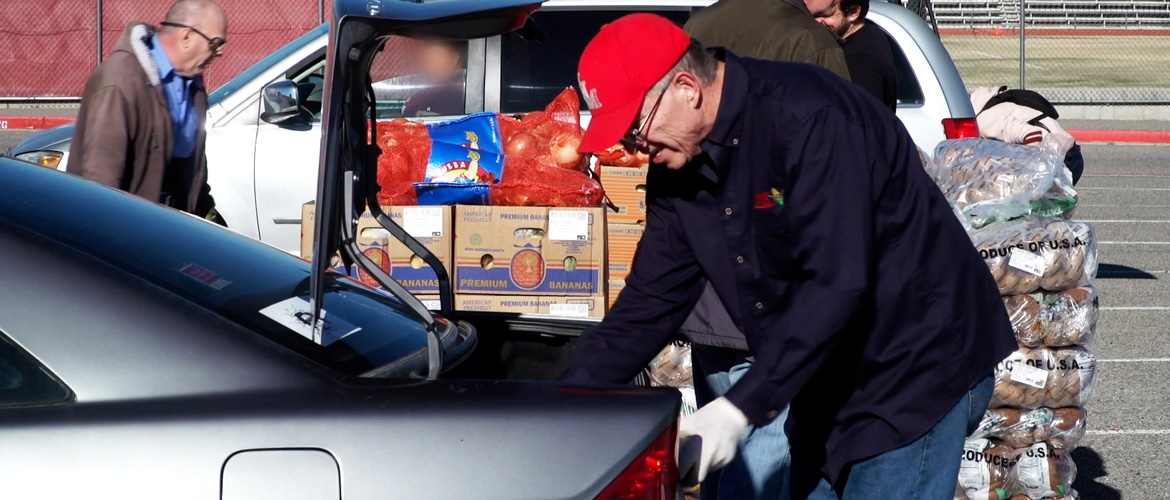Food insecurity persists even as the economy rebounds from the downturn caused by the COVID-19 pandemic. More than 13% of New Mexico’s 860,000 households have trouble accessing food to feed their families.
Sonya Warwick, director of communications and events at the Albuquerque-based Roadrunner Food Bank, has collected some of their heartbreaking stories to bring awareness to the state’s hunger problem.
“My husband is unemployed, and we do get Social Security,” a food bank client says. “It’s such a small income. (The food bank) does help supplement what we can afford to buy at the store. Our medications are necessary, but expensive, and we are struggling to keep up with paying utilities and our mortgage right now.”
With one of the nation’s highest poverty rates, New Mexico already struggled to feed its 2 million residents. The national public health crisis exacerbated the problem.
Since the pandemic, almost 325,000 people statewide have experienced hunger, Warwick says. Yet, roughly 20% of the state’s food pantry network closed, making it more difficult to get food to some of the state’s most rural and disadvantaged areas.
“Food insecurity is a very significant issue in our state,” she says.
Blue Cross and Blue Shield of New Mexico (BCBSNM) has a longstanding commitment to investing in Roadrunner Food Bank and supporting sustainable resources and strategies to combat hunger and improve health.
“We know that economic stability and food security have a significant impact on health outcomes.”
Roadrunner Food Bank, with help from the national hunger-relief organization Feeding America, buys nutritious and culturally appropriate foods for communities it serves. It also is developing and implementing policies focused on finding a larger variety of nutritious foods needed to help prevent diet-related conditions that can compromise its clients’ health.
“We know that economic stability and food security have a significant impact on health outcomes,” says Janice Torrez, BCBSNM president. “Our partnership with Feeding America is designed to fight hunger and improve nutrition for families throughout New Mexico, addressing a critical health and social issue facing our state.”
Other New Mexico food banks BCBSNM supports through Feeding America include the Community Pantry in Gallup, Food Depot in Santa Fe and Food Bank of Eastern New Mexico in Clovis.
In 2020, almost 11% of American households had trouble feeding all family members, according to a U.S. Department of Agriculture report. Meantime, existing gaps between white households and those of people of color expanded, with nearly 22% of Black households experiencing food insecurity, compared with a little more than 7% of white households. More than 17% of Hispanic households had trouble accessing food.
That struggle to feed themselves and their families puts people at risk for a lifetime of poor health outcomes and disparities. Research shows food insecurity can lead to hypertension, stroke, cancer, diabetes, chronic obstructive pulmonary disease and kidney disease.
“When someone has food insecurity, they're oftentimes dealing with trade-offs with food and other basic needs or engaging in coping strategies such as eating fewer meals or watering down their meals,” says Jessica Hager, Feeding America’s director of health care partnerships and nutrition.
Those trade-offs can lead to developmental delays and behavioral issues for children and disease management problems for adults with diabetes and other health conditions, Hager says.
A focus on nutrition and culture
This year BCBSNM has invested in Feeding America’s work focusing on closing nutritional gaps, addressing health disparities and creating culturally competent connections with food bank clients. The New Mexico organizations are among 26 food banks carrying out this work with Feeding America grants supported by Blue Cross and Blue Shield plans in Illinois, Montana, New Mexico, Oklahoma and Texas.
The projects include surveying and engaging their communities to understand their food needs and cultural preferences, while building trust with the people they serve and working to provide communities with a better balance of nutritious foods.
“This goes beyond food categories of protein, dairy and produce, but really what are the specific ingredients that are traditional or special in one's culture,” Hager says. “We know that in the United States there's such great diversity in our food and the cultures that are represented, and we as a food bank network want to be able to meet those food needs and preferences.”
The Roadrunner Food Bank, which works with about 500 community partners to provide nourishing meals to residents statewide, is assessing the need for more culturally appropriate foods and targeting a few areas, including Native American communities. Of the nearly 34 million pounds of food distributed last year, about 17.6 million went to Native American communities.
“We always knew we need to do deeper work with our Native American population,” says Warwick, which can be challenging because some Native American communities lack infrastructure, including roads, water or cold storage.
Additionally, the food bank is partnering with providers and clinics to improve New Mexicans’ health outcomes. Its Healthy Foods Center, a medical-referral food pantry, served more than 350 households, providing chronically ill patients access to healthy foods, nutrition education and other services.
The food bank also set up Healthy Foods Markets at health care clinics and sites where people with chronic health issues could pick up nutritious foods. It served more than 11,500 households last year.
“I have a heart and kidney issue,” says a food bank client. “The medical costs and prescriptions have been so expensive. This program helps provide me the healthy food, and we are so grateful to have it.”

